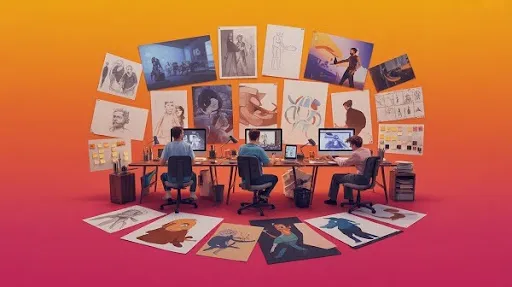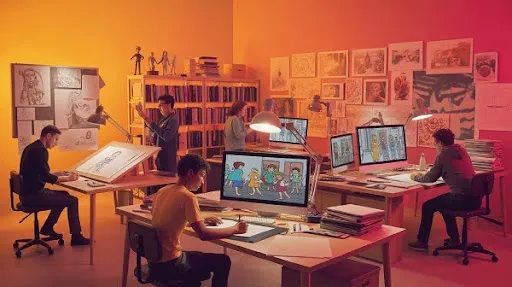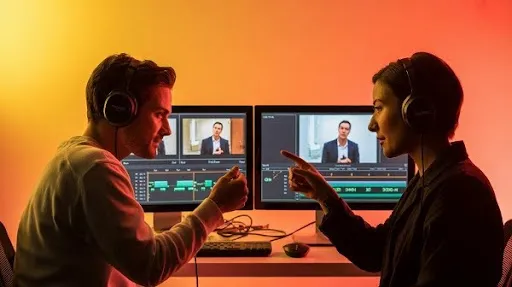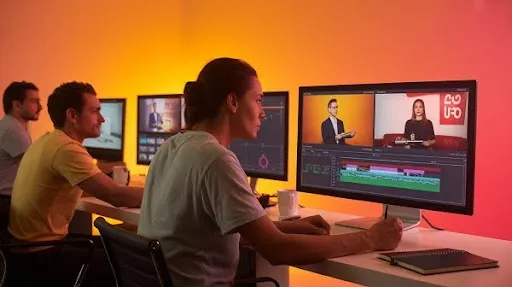Some artists freeze the moment they sit down to create. Not because they lack skill, but because they fear they’ll end up looking like someone else. Every creative person hits this point. You want a voice that feels yours.
You want your drawings, animations, characters, or scenes to carry a spark that instantly feels familiar to people who follow your work. That desire is real, and it’s powerful.
The good news is that developing your artistic style isn’t a mystical talent. It’s shaped by choices, habits, trials, and small breakthroughs. Once you start paying attention to these things, your work begins to form a personality. That personality becomes your identity. And that identity becomes your personal artistic signature.
As a video animation agency and animation studio, Prolific Studio sees this every day. Artists walk in unsure of their voice and walk out with a style strong enough to support full productions, character design systems, animated memes, and even large-scale projects for brands. The same process can work for you.
This guide unlocks the best ways for developing your artistic style with clarity, structure, and a little encouragement. No fluff. No generic advice. Just practical steps that push you toward developing your unique art style with confidence.
Trying Tools That Shape Your Artistic Voice Unique
Explore Media Intentionally
Before your work becomes recognizable, your hands need time to explore. Tools shape your speed, line quality, accuracy, and emotional tone. Artists tend to forget this. They blame themselves for “not having a style” when their tools don’t even match their instincts.
Spend time testing tools without pressure. Try charcoal one day, gouache the next, digital brushes after that. Use anything that forces your hand to respond differently. You’ll start noticing what feels comfortable and what feels forced. Comfort doesn’t mean “easy,” it means your creativity flows without that tight feeling in your chest.
Notice What Feels Natural
Some people enjoy loose motion; some prefer sharp edges. Mediums bring this out instantly:
- The pencil gives a soft rhythm.
- Ink gives bold decisions.
- Digital brushes give endless control.
- Watercolors add surprise.
Once you understand why something feels natural, you start stepping closer to your future style.
Finding Artists or Artistic Styles That Speak to You
Identify What Your Eyes Keep Returning To
Every person has visual preferences stored deep inside. Most ignore them. But if you pause, you’ll notice your mind returns to certain artists or artistic styles without asking for permission. That’s your internal compass pointing somewhere important.
Pick three artists. Three pieces each. Now ask yourself:
- Do their colors attract you?
- Do their lines feel gentle or fierce?
- Do their characters show personality through poses?
- Do their backgrounds feel minimal or detailed?
You’re not studying them to copy. You’re studying them to understand what your instincts gravitate toward. Once you understand your attraction, your artistic journey becomes clearer.
Break Down the Elements
Separate their work into small chunks:
- Color flow
- Shadow behavior
- Brush personality
- Texture placement
- Line confidence
- Mood consistency
Everything you admire is a clue to your own style. Your artistic DNA already holds these preferences. You’re not creating something brand new out of thin air; you’re giving shape to the things you already love.
Creating Consistently to Understand Your Own Choices
Quantity Builds Clarity
You can’t analyze a style you haven’t produced yet. Make a large batch of work without judging any of it. Fast sketches. Slow studies. Characters you invent on the spot. Scenes from daily life. Environments inspired by games. Try designs that could fit in 2D animation studio projects or 3D animation studio reels.
At first, it feels messy. But the more you create, the easier it becomes to see patterns.
Look for Recurring Patterns
Set your pieces aside. Then return after a week. Patterns jump out when you’re emotionally detached:
- Do you keep using similar palettes?
- Do you naturally lean toward soft lighting?
- Do you prefer thick outlines or thin ones?
- Do you repeat certain textures?
- Do your characters share similar energy?
These repetitions are not accidents. They are early signs of your artistic DNA surfacing.
Mixing Influences to Shape Your Unique Art Style
Combine What Works for You
Style doesn’t appear fully formed. It emerges from combinations. Maybe you love the gritty texture from one artist and the soft shading from another. Maybe your personal sketches feel more honest than your polished work. Blend the things that resonate with you until something clicks.
Think of it like creating a recipe that only you would choose. Someone else wouldn’t mix those elements together. Someone else wouldn’t arrange the shapes that way. This mixture begins forming a voice that feels yours.
Apply These Blended Elements to Subjects You Love
Creating something based on a subject you don’t enjoy rarely brings out your best voice. Choose themes that charge you:
- Fantasy environments
- Humorous character expressions
- Soft portrait studies
- Stylized animals
- Sci-fi props
- Backgrounds for types of video content
- Characters for styles for video games
The more excited you feel about the subject, the more your personality seeps into the art.
Using Constraints To Strengthen the Heart of Artistic Development
Constraints often scare artists at first. They feel like restrictions. They’re actually one of the fastest ways to sharpen your style. When you limit options, your creativity works harder. That extra effort exposes your raw preferences.
Try Simple Boundaries
A few examples:
- Only black ink for a week
- Only three colors for a month
- Only head sketches for an hour daily
- Only side profiles for two days
- Only geometric backgrounds
- Only silhouettes
You’ll find fresh ideas in the limitations. Unexpected marks. Surprising shapes. Slight quirks. These small discoveries add to the heart of artistic development.
Intentional Practice Builds Confidence and Control
Focused Sessions Change Everything
Casual doodling keeps your hand loose, but targeted sessions build skill. If you want a style that feels strong, intentional practice becomes essential.
Choose an element and stick to it for the session:
- Brush pressure
- Contrast balance
- Light direction
- Character proportions
- Texture layering
- Clothing folds
- Color transitions
- Gesture energy
You’re not just drawing. You’re sharpening control. That control supports your unique style more than anything else.
The Hidden Advantage
Focus gives you clarity. Clarity gives you consistency. Consistency builds recognizability. Recognizability becomes your personal artistic signature.
Blocking Out Digital Noise So Creativity Has Room To Grow
Screens drain your energy fast. Constant scrolling fills your head with too many voices. Comparison steals your confidence. You start doubting your progress. That doubt kills style development.
Keep your attention on your own growth. Social media is great for inspiration and community, but not for comparison. When you quiet the noise, your internal voice becomes louder. That voice is where your style lives.
Mistakes Fuel Your Artistic Journey Instead of Slowing It Down
Nothing shapes an artist more than trial and error. Every “wrong” stroke shows you something you didn’t know. Mistakes show tendencies you weren’t aware of. They push you toward solutions that eventually define your identity.
Treat mistakes as notes. Not judgments. Notes guide you. Notes help you adjust. Notes push you closer to a stronger artistic identity.
Using Pre-Production in Game Art to Strengthen Your Identity
Game artists often develop their voice during pre-production in game art. This stage forces clarity. You decide how characters behave, how shapes feel, how props add personality, and how the environment supports the story. Every choice exposes your preferences.
Test Your Style Through Character Sheets
Create turnarounds, expressions, costumes, and quick silhouettes. You’ll notice that your characters bend in certain ways. They hold emotions in a style that feels consistent. They react with movement that carries your personal rhythm.
Explore Environments Through Simple Layouts
Work with light sources, rough shapes, and basic colors. This helps you understand how your style treats space. Maybe your angles feel sharp. Maybe your shadows soften edges. Your style becomes easier to spot when you build small scenes.
Compare Promotional Art vs In-Game Art
Promotional pieces need drama. In-game pieces need clarity. Promotional art and in-game art help you understand your limits and your strengths.
Promotional art shows how far your rendering can go. In-game art shows how efficient you can be.
Artists who learn this balance develop a stronger personal style by mastering both storytelling and structure.
Learning From Types of Video Content to Expand Your Range
Modern creativity isn’t limited to one canvas. Artists contribute to types of video content every day, explainers, trailers, social clips, animated memes, game reels, pitch videos, educational shorts, and brand content.
Each format teaches you something new.
Explainers Sharpen Clarity
Explainer videos force you to create clean shapes, readable poses, and simple action. This helps artists learn what visual decisions matter most.
Trailers Teach Mood
Trailers rely on rhythm, contrast, and pacing. Studying them helps you understand how your style interacts with motion and tone.
Animated Memes Push Personality
Animated memes may feel silly at first, but they’re great for discovering voice. You’ll find new ways to exaggerate expressions, punch timing, and simplify shapes so they stay funny and quick.
Educational Content Builds Precision
You learn to communicate ideas visually without distractions. That level of clarity influences your personal artistic signature.
Working across these content types trains you to be adaptable. That adaptability gives your style dimension instead of locking you into one look.
Letting an Animation Studio Workflow Sharpen Your Decisions
An animation studio environment runs on consistency. Every drawing, shot, or layout supports the next. That pressure helps artists refine their artistic DNA quickly.
Storyboards Reveal Your Natural Flow
Boards show your natural pacing, your instinct for staging, and your choices in framing. You’ll see how your style guides attention even before rendering begins.
2D Animation Studio Work Enhances Shape Language
A 2D animation studio teaches you discipline with lines, arcs, spacing, and silhouettes. Artists come out with sharper clarity because every frame forces them to repeat their decisions dozens of times.
3D Animation Studio Work Strengthens Your Eye for Detail
A 3D animation studio environment adds structure. You learn how your style adapts to models, textures, lighting, and movement. Even if you stay 2D, exposure to 3D helps you understand dimension and volume.
Once you experience both, your personal style becomes stronger. You know what to exaggerate. You know what to tone down. You know which details carry meaning.
Frequently Asked Questions
How long does it take to find a personal artistic signature?
It varies for each artist. Some find signs early. Others take longer. The key is consistent creation. The more you draw, the faster your traits reveal themselves.
Can my style change later on?
Yes. Style grows with experience. You’ll notice new details forming as your interests change. Growth strengthens your identity instead of replacing it.
Do I need to study other artists to develop my artistic style?
Studying others helps you understand your preferences. You’re not copying them. You’re learning what resonates with you so you can shape your own path.
Does animation experience help with style development?
Very much. Working with a video animation agency, a 2D animation studio, or a 3D animation studio exposes you to structure, timing, visual consistency, and clarity. These skills refine your style.
Is it okay if my style mixes many influences?
Yes. Most strong styles come from combinations. Your mix becomes your identity.
How do I know if my style is strong enough?
When your work feels honest, consistent, and recognizable across multiple pieces, you’re on the right track.
Final Words
You don’t build style by waiting for inspiration. You build it by drawing, testing, refining, and trusting your choices. Every stroke adds to your artistic DNA. Every experiment sharpens your voice. The more you create, the clearer your identity becomes.
If you want help shaping your direction, Prolific Studio can support you with structure, guidance, and creative freedom. As a full video animation agency, we help artists strengthen their voice across projects, from animated memes to game assets to full productions.
Your identity deserves space to grow. Give it that space, and your style will reward you with confidence you can feel in every piece you make.
Related Articles:










